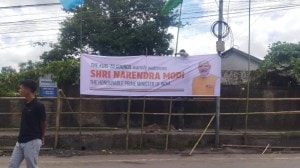Some shining moments in a bleak week
Though Galbraith got short shrift, TV redeemed itself with its speedy, mature handling of the other tragedies

If John Kenneth Galbraith’s were the only reporting-worthy death in the last seven days — Suryanarayan, the residents of Vadodara, Pramod Mahajan and Naushad complete the necessarily grim list — would TV news have given his legacy so short a shrift? The utterly perfunctory treatment given to Galbraith by news channels — I recall only NDTV Profit running a small clip — is all the more unfortunate because, first, I think TV did a fairly good job of covering the other tragedies and, second, I disagree with one popular criticism leveled against broadcast news this week.
Was there any degree of popular disaffection, even among SEC I viewers, that Galbraith didn’t deserve more than a mention? I don’t know but I hope there was. I also don’t know whether the two English language channels, NDTV and CNN-IBN, which I expected to have some substantive interest in Galbraith, owed their relative disinterest to perceptions about the market. Whatever the reason, I find it more than a little worrisome that news channels that count English-speaking chattering classes among their viewers didn’t spend more time on one of the most remarkable public intellectuals of our time.
Just how remarkable was evident from the BBC re-run of Tim Sebastian’s 1999 interview of Galbraith. Sebastian, who can snarl with the best of them, looked almost grateful at the chance to chat.
I felt almost grateful when major news channels covered the Suryanarayan tragedy by quickly getting in foreign affairs editors or correspondents who had done their homework to give a context to the tragedy. CNN-IBN’s and Aaj Tak’s commentaries got to the point the fastest. This small effort made a noticeable difference — most channels escaped the banality that hour-by-hour repetition of any tragedy descends into. In fact, major channels made a similar effort while reporting Mahajan’s death and his funeral (I am not including Vadodara analysis in this because broadly contextualising Gujarat communal violence is the easiest thing in Indian journalism).
That TV reporters were no longer required to “analyse” Mahajan’s medical bulletins made a difference, of course. But when the editors and/or senior editors took charge of anchoring the Mahajan story, they made a difference, too, most notably on Aaj Tak, NDTV and CNN-IBN. Times Now, editorially weak again, put together the best Mahajan montage. There was no voice over, as there wasn’t in Aaj Tak’s footage of Vadodara streets. Those images were powerful and far more effective than NDTV’s rather strenuous efforts to put together a locality-under-siege report. The clock striking the midnight hour, the long shots of streets, the jump cut to the grieving relative of a riot victim — it seemed a little manufactured and a little precious.
Tasteless is the verdict of many viewers about close up shots of Suryanarayan’s grieving family. Television’s insensitivity and its extremist intrusiveness were mentioned. I don’t agree. My take is this: each one of us, should we have the misfortune of becoming news worthy via a personal loss, has the right and the choice of barring TV cameras from our homes. Would TV news crews insist on staying if the fundamental right of a householder to determine who can be with him and when is made clear? How much the media intrudes depends sometimes on how much we let it intrude.
(saubhik.chakrabarti@expressindia.com)
Photos





- 01
- 02
- 03
- 04
- 05


























